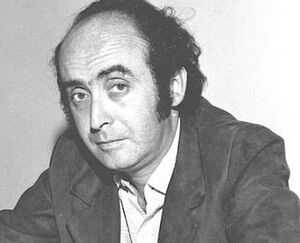Vladimir Herzog facts for kids
Quick facts for kids
Vladimir Herzog
|
|
|---|---|
 |
|
| Born |
Vladimir Herzog
27 June 1937 |
| Died | 25 October 1975 (aged 38) |
| Education | Bachelor's degree, University of São Paulo |
| Occupation | Journalist Professor Playwright |
| Spouse(s) | Clarice Herzog |
| Children | Ivo & Andre Herzog |
Vladimir Herzog (27 June 1937 – 25 October 1975), nicknamed Vlado (a usual Croatian abbreviation for the name Vladimir) by his family and friends, was a Brazilian journalist, university professor and playwright of Croatian-Jewish origin and born in today´s Croatia. He also developed a taste for photography, because of his film projects.
Biography
Early life
Herzog was born in Osijek, Kingdom of Yugoslavia province of Sava Banovina (currently Croatia) on 27 June 1937, to Zigmund and Zora Herzog, a Croatian Jewish family who emigrated to Brazil in the early 1940s, to escape Nazi and Ustashe persecution.
Education and career
Herzog received a bachelor's degree in Philosophy from the University of São Paulo in 1959. He became a naturalized Brazilian citizen in 1961 After his graduation, he worked as a journalist in the major media outlets in Brazil, notably in the newspaper O Estado de S. Paulo. During that period he decided to use "Vladimir" instead of "Vlado" as his first name, because he felt that his real name sounded extremely exotic in Brazil. Following the 1965 right wing coup d'état Herzog together with his wife Clarice Ribeiro Chaves, moved to Britain, where for three years he worked in London for the BBC. They returned to Brazil in late 1968.
In the 1970s Herzog became the editor-in-chief of TV Cultura, a public TV station managed by the São Paulo State government. He also became a journalism professor at the University of São Paulo School of Communication and Arts and at Fundação Armando AlvCorrectares Penteado's Journalism course. Alongside this, he developed a career as a playwright, mixing with the artistic and theater Intelligentsia of Brazil. Later in his life, Herzog became active in the civil resistance movement against the military dictatorship in Brazil, as a member of the Brazilian Communist Party (Portuguese: Partido Comunista Brasileiro - PCB). As a news director at the TV station, Herzog advocated the responsibility of journalists to society and reported on the first decade of the Brazilian military dictatorship. Military intelligence spies working inside the TV station reported to their handlers that Herzog is "a problem for the military regime."
Arrest and death

On 24 October 1975 – when Herzog was already editor-in-chief of TV Cultura – Brazilian Army agents summoned him to testify about his connections with the then outlawed PCB Party. The following day, Herzog went to the DOI-CODI in order to comply with the summons. This meeting however, was actually a ruse to conduct an interrogation of Herzog. He was arrested with other two journalists, Jorge Duque Estrada Benigno and Rodolfo Konder.
On 25 October, Herzog's body was found in his prison cell. At the request of several religious and human rights groups, the Inter-American Commission on Human Rights, an independent arm of the Organization of American States, investigated the conflicting circumstances surrounding the death of Vladimir Herzog, and found that the Brazilian junta arrested and murdered Herzog because of his activities as a journalist.
Aftermath
Herzog was married to advertising agent Clarice Herzog, with whom he had two young children. Three years later, she was able to legally blame the state for the death of her husband. Later, in a civil lawsuit filed by his widow against the government, a federal tribunal recognized his wrongful death and granted monetary damages to Herzog's family.
The death of Herzog boosted the movement against the military dictatorship in Brazil. Generating a wave of protests from the international press, and initiating a process in defense of human rights in Latin America.
Herzog's eath is seen today as the beginning of the end of the Brazilian military dictatorship. Herzog has become a symbol of the fight for democracy in Brazil and has been honoured in many ways, such as by attributing it to the street where the TV Cultura is located in São Paulo. In addition, a public prize for journalism devoted to amnesty and human rights has been established with his name (Prêmio de Jornalismo Vladimir Herzog de Anistia e Direitos Humanos).
Legacy
In 2009, over 30 years after Herzog's death, the Vladimir Herzog Institute was founded. Its aims are to archive material about Herzog, to promote debate about the role of journalists and new media, and to award the Vladimir Herzog Prize for Amnesty and Human Rights to journalists and human rights activists.
See also
 In Spanish: Vladimir Herzog para niños
In Spanish: Vladimir Herzog para niños

